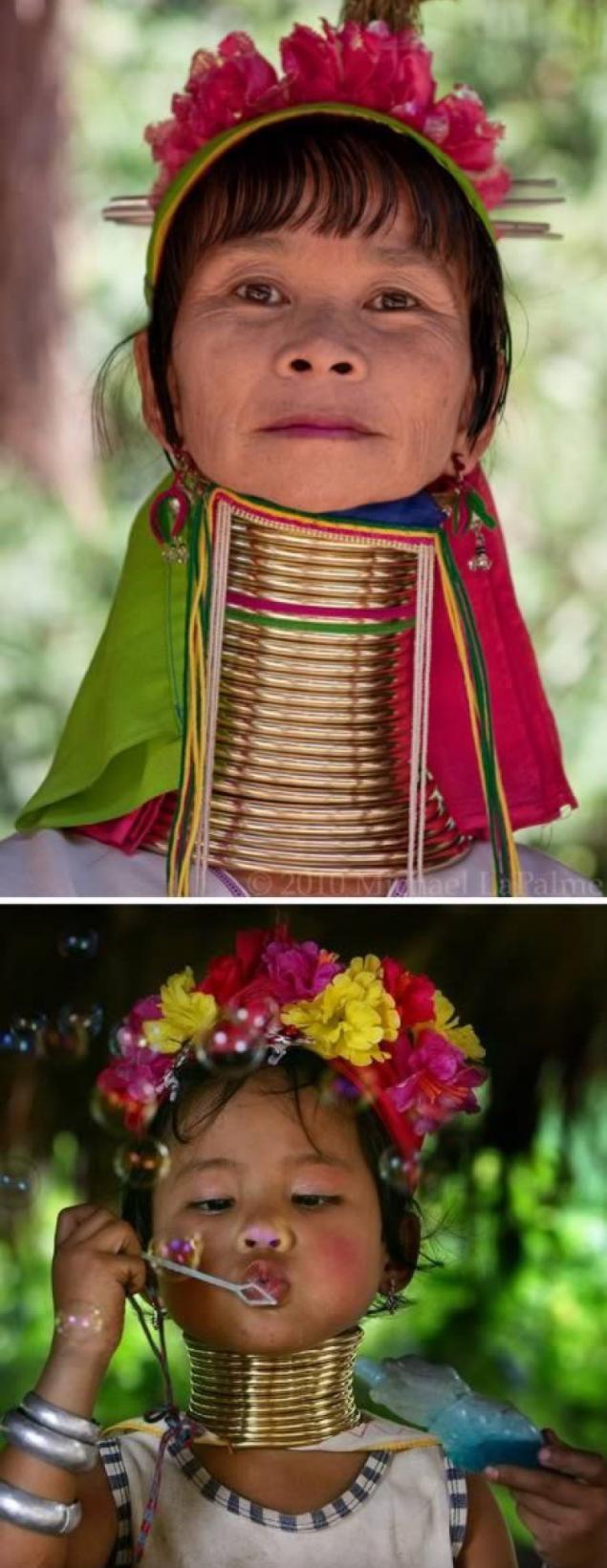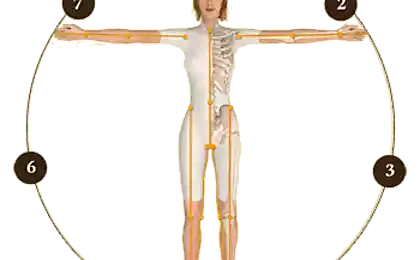1219
8, the most extreme body modification in various cultures
Today we want to tell you about the most extreme body modifications adopted in different cultures.

It is difficult to say who was the first nation in which the tension applied ears, and why they did it. Now, many cultures (including our own) are used creative stretched ears for different reasons. Religion, rituals associated with age, distilled evil spirits, sexuality and physical beauty are common motivations. However, this is just the tip of the possible causes. People from all over the world still practice modifications ears. From the Masai tribes in Kenya, to the people Huaorani (Huaorani) in the Amazon river basin stretched ears are still quite common. The fact that the western youth can go to the piercing parlor and choose a suitable tunnel or other aural decoration and youth ethnic group Hmong (Hmong) choose for themselves the silver tube, is an interesting example of human culture.

People apatani people (Apatani) lives in the north-east of India in the state of Arunachal Pradesh (Arunachal Pradesh). Women apatani people were considered among the most beautiful among the tribes of Arunachal (Arunachal). So beautiful that they had to make themselves unappealing to avoid invaders from other tribes. For this woman Apanti large wooden plugs inserted in their noses - a tradition at this time is no longer supported in the tribe, consisting of 26,000
.
Most boys and girls Dinka tribe (Dinka) do not cry when a local shaman brings the red-hot knife to their dark faces. If they wince, cry or react to pain - they will lose their status in the community so that it is better to remain completely calm during the process. Scarification persons practiced throughout Sudan, and various traces on the face is decorated with tribal representatives and the women of the tribe are its hallmark.
The men from the Dinka tribe, living in South Sudan, in order to show their courage to do on their faces three scars in the form of parallel lines running across the forehead. Dink Boys get scars in adulthood, as a transition to adulthood when they become equal members of a nomadic tribe.
For some this is too extreme, but it is quite normal for local Thais. They ignore the pain as this ritual is a rite of passage into adulthood. This annual ritual held in public in order to announce to the world that they have become adults.
Vegetarian Festival in Puhkete (Phuket) is full of religious rites. Confluence into a trance and piercing - part of the tradition. The festival is held on the island Puhket located in the south of Thailand, every October. Most impressive are the processions that take place every morning for ten days of the festival. In the processions can be seen followers of various saints who are "mediums" of Chinese gods. Some of the mediums pierce their cheeks with sharp objects (mostly metal), thus proving the exclusion in relation to themselves and the rest of society. Other rituals is walking barefoot on hot coals and the stairs with pointed beams.
All mediums are in a state of trance, allowing them to withstand long session piercing. Although it is believed that the wound is fully healed after the festival each year on their faces, new scars.

Sharpening of the teeth - a practice in which the manually sharpened teeth, usually the front incisors. In the history of humanity, this form of body modification was used in many cultures. In Bali teeth trimmed due to the fact that the teeth were associated with evil, jealousy and other negative emotions. Teeth also sharpens during the rite of passage into adulthood. Sharpening of the teeth was also used in Vietnamese and Sudanese tribes. In the culture of the Maya not only sharpen the teeth, but they were applied more and different figures as the sign of the higher strata of society. In many cultures, sharpened teeth to mimic animals - for example, in Vapare tribe (Wapare) in Africa to sharpen his teeth in an attempt to simulate a shark, and to achieve maturity, beaten out several lower teeth
.
Despite the fact that scarification used in many nations around the world, in the Sepik River tribes (Sepik), Papua New Guinea, scarification is an important part of the initiation rite into manhood. This part of the ceremony, which lasts a few weeks, and in that, in addition to scarring, also includes public humiliation. The elders of the tribe with the help of the blade cuts applied to young men, so that when the skin is healed - she looked like alligator skin. They believe that an alligator and then devour all remnants of the boy in the body and thus, the teenager will become a man.

Plate for the lips - a type of body modification. Increasing the plate (usually circular, made of wood or clay) are inserted into the top or bottom of the punched (and sometimes both) lip than its stretch. Archaeological finds indicate that the labret were independently invented at least six times - in the Sudan and Ethiopia (8700 BC), in Mesoamerica (1500 BC) and Ecuador (500 BC ). At the moment, the tradition is maintained in several tribes living in Africa and the Amazon.
In Africa, during installation in the lower lip plate is usually removed two lower front teeth, and sometimes all four. The tribes Sara (Sara) and Lobi (Lobi) plate is also inserted in the upper lip. In other tribes, such as the Makonde (Makonde), plates are only in the upper lip. Many older sources it is believed that the size of the plate is in some tribes indicator of social or economic status. However, if we consider the properties of human skin, the size of the plate rather depends on the stage of stretching of the lips and the wishes of the wearer plate.

Women Padaung (Kayan) from the north of Thailand known for their subtle and incredible brass rings they wear around his neck. Some of it is referred to as "long-necked" or "giraffe women". Women can wear up to 25 rings, and many of them never take off their rings.
According to the myth, if you remove the women neck rings are broken or can not support the head, but this is not true. Maeneng (Maeneng), depicted in the picture above, is the head of his village and the only one who has 25 rings. It often helps to repair and correct the rings of other women.
Children often put on the first ring at the age of five years. The first set weighs about 2 kg, and new rings are added gradually. In fact, women do not have the Padaung elongated necks, it works differently. Due to the weight gradually descends clavicle rings, and with the addition of new rings, it falls even lower, compressing the chest. After the fall below the shoulders - a feeling that women's neck lengthened
. : Bugaga.ru
Loading ... Loading ... Loading ...
Liked? Share with your friends!
Loading ... Loading ...

It is difficult to say who was the first nation in which the tension applied ears, and why they did it. Now, many cultures (including our own) are used creative stretched ears for different reasons. Religion, rituals associated with age, distilled evil spirits, sexuality and physical beauty are common motivations. However, this is just the tip of the possible causes. People from all over the world still practice modifications ears. From the Masai tribes in Kenya, to the people Huaorani (Huaorani) in the Amazon river basin stretched ears are still quite common. The fact that the western youth can go to the piercing parlor and choose a suitable tunnel or other aural decoration and youth ethnic group Hmong (Hmong) choose for themselves the silver tube, is an interesting example of human culture.

People apatani people (Apatani) lives in the north-east of India in the state of Arunachal Pradesh (Arunachal Pradesh). Women apatani people were considered among the most beautiful among the tribes of Arunachal (Arunachal). So beautiful that they had to make themselves unappealing to avoid invaders from other tribes. For this woman Apanti large wooden plugs inserted in their noses - a tradition at this time is no longer supported in the tribe, consisting of 26,000
.

Most boys and girls Dinka tribe (Dinka) do not cry when a local shaman brings the red-hot knife to their dark faces. If they wince, cry or react to pain - they will lose their status in the community so that it is better to remain completely calm during the process. Scarification persons practiced throughout Sudan, and various traces on the face is decorated with tribal representatives and the women of the tribe are its hallmark.
The men from the Dinka tribe, living in South Sudan, in order to show their courage to do on their faces three scars in the form of parallel lines running across the forehead. Dink Boys get scars in adulthood, as a transition to adulthood when they become equal members of a nomadic tribe.
For some this is too extreme, but it is quite normal for local Thais. They ignore the pain as this ritual is a rite of passage into adulthood. This annual ritual held in public in order to announce to the world that they have become adults.
Vegetarian Festival in Puhkete (Phuket) is full of religious rites. Confluence into a trance and piercing - part of the tradition. The festival is held on the island Puhket located in the south of Thailand, every October. Most impressive are the processions that take place every morning for ten days of the festival. In the processions can be seen followers of various saints who are "mediums" of Chinese gods. Some of the mediums pierce their cheeks with sharp objects (mostly metal), thus proving the exclusion in relation to themselves and the rest of society. Other rituals is walking barefoot on hot coals and the stairs with pointed beams.
All mediums are in a state of trance, allowing them to withstand long session piercing. Although it is believed that the wound is fully healed after the festival each year on their faces, new scars.

Sharpening of the teeth - a practice in which the manually sharpened teeth, usually the front incisors. In the history of humanity, this form of body modification was used in many cultures. In Bali teeth trimmed due to the fact that the teeth were associated with evil, jealousy and other negative emotions. Teeth also sharpens during the rite of passage into adulthood. Sharpening of the teeth was also used in Vietnamese and Sudanese tribes. In the culture of the Maya not only sharpen the teeth, but they were applied more and different figures as the sign of the higher strata of society. In many cultures, sharpened teeth to mimic animals - for example, in Vapare tribe (Wapare) in Africa to sharpen his teeth in an attempt to simulate a shark, and to achieve maturity, beaten out several lower teeth
.

Despite the fact that scarification used in many nations around the world, in the Sepik River tribes (Sepik), Papua New Guinea, scarification is an important part of the initiation rite into manhood. This part of the ceremony, which lasts a few weeks, and in that, in addition to scarring, also includes public humiliation. The elders of the tribe with the help of the blade cuts applied to young men, so that when the skin is healed - she looked like alligator skin. They believe that an alligator and then devour all remnants of the boy in the body and thus, the teenager will become a man.

Plate for the lips - a type of body modification. Increasing the plate (usually circular, made of wood or clay) are inserted into the top or bottom of the punched (and sometimes both) lip than its stretch. Archaeological finds indicate that the labret were independently invented at least six times - in the Sudan and Ethiopia (8700 BC), in Mesoamerica (1500 BC) and Ecuador (500 BC ). At the moment, the tradition is maintained in several tribes living in Africa and the Amazon.
In Africa, during installation in the lower lip plate is usually removed two lower front teeth, and sometimes all four. The tribes Sara (Sara) and Lobi (Lobi) plate is also inserted in the upper lip. In other tribes, such as the Makonde (Makonde), plates are only in the upper lip. Many older sources it is believed that the size of the plate is in some tribes indicator of social or economic status. However, if we consider the properties of human skin, the size of the plate rather depends on the stage of stretching of the lips and the wishes of the wearer plate.

Women Padaung (Kayan) from the north of Thailand known for their subtle and incredible brass rings they wear around his neck. Some of it is referred to as "long-necked" or "giraffe women". Women can wear up to 25 rings, and many of them never take off their rings.
According to the myth, if you remove the women neck rings are broken or can not support the head, but this is not true. Maeneng (Maeneng), depicted in the picture above, is the head of his village and the only one who has 25 rings. It often helps to repair and correct the rings of other women.
Children often put on the first ring at the age of five years. The first set weighs about 2 kg, and new rings are added gradually. In fact, women do not have the Padaung elongated necks, it works differently. Due to the weight gradually descends clavicle rings, and with the addition of new rings, it falls even lower, compressing the chest. After the fall below the shoulders - a feeling that women's neck lengthened
. : Bugaga.ru
Loading ... Loading ... Loading ...
Liked? Share with your friends!
Loading ... Loading ...
25 Photo For a great mood for all holidays!
"Down with the hijab and the burqa" - First Lady of Qatar Breaks secular foundations of the Muslim World!























